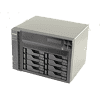 1
1
Asustor AS6208T 8-bay NAS Review
Multimedia Apps & Multimedia performance »Storage Manager
Storage Manager allows you to check on or configure the NAS server's volume(s). You can also check the disks and create an iSCSI target and LUN. Using iSCSI will make the disks inside the NAS appear as local disks on any client PC; however, all data will be transferred to and from them over the network. LUN stands for Logical Unit Number: numbered disk drives the client PC's operating system sees as volumes.
The volume setup wizard will help you create a RAID array. With all eight HDD bays occupied, you have a wide range of options to select from for your storage configuration.
Access Control
Configure user- and group accounts, set domain users and groups, manage shared folders, and set application privileges in ADM's Access Control panel. You can also set user access rights to various applications for individuals or groups here. You can, for instance, deny some users access to such sensitive applications as Surveillance Center. Surveillance Center's icon won't be available to those users in ADM.
Creating a shared folder in ADM is a piece of cake. It is also possible to encrypt folders. ADM only supports folder encryption, not volume encryption. The ability to encrypt folders is usually preferable since it gives you more control over your encrypted content (users usually only want portions of their data encrypted, not the entire volume). However, we believe Asustor should offer volume encryption as well.
Services
These options allow you to enable some of the additional services ADM includes, such as Windows file service, Mac file service, NFS, FTP server, terminal service, etc. You should enable the terminal service option if you are looking to connect to the NAS through SSH.
App Central
You will find numerous interesting applications in App Central, and installing them is easily done.
Asustor and its third party users and companies did a tremendous job with App Central, so there are currently many applications you can pick from for your Asustor NAS server.
System Info
The System Information window contains information on the NAS server's hardware model, its software version, network settings, and the system's present state. It also displays information on online users and has a useful log feature.
Activity Monitor
Activity Monitor shows how heavily the CPU's cores, memory, and network port are being utilized. It also shows how heavily the disks are being taxed and lists all running processes and the resources these use.
External Devices
You can format an external storage device into all popular file systems. The External Devices menu allows you to control all currently connected devices.
Feb 28th, 2025 07:13 EST
change timezone
Latest GPU Drivers
New Forum Posts
- What is your comfortable price range for a graphics card? (15)
- Nvidia's GPU market share hits 90% in Q4 2024 (gets closer to full monopoly) (689)
- Authenticode fails for GPU-Z 2.63.0 (15)
- What local LLM-s you use? (84)
- Free Games Thread (4503)
- Weird electrical vibration on left side of laptop. (27)
- Opinions on the drive config for new build please (33)
- Looking for Palit 5090 Gamerock OC BIOS (3)
- How to setup my 9800X3D on this Asus X670E board properly (6)
- Windows 11 General Discussion (5730)
Popular Reviews
- Montech HyperFlow Silent 360 Review
- ASUS GeForce RTX 5070 Ti TUF OC Review
- Gigabyte X870 Aorus Elite WiFi 7 Review
- Corsair Xeneon 34WQHD240-C Review - Pretty In White
- AMD Ryzen 7 9800X3D Review - The Best Gaming Processor
- be quiet! Pure Base 501 DX Review
- MSI GeForce RTX 5070 Ti Ventus 3X OC Review
- MSI GeForce RTX 5070 Ti Vanguard SOC Review
- ASUS ROG Harpe Ace Mini Review
- Corsair Virtuoso MAX Wireless Review
Controversial News Posts
- NVIDIA GeForce RTX 50 Cards Spotted with Missing ROPs, NVIDIA Confirms the Issue, Multiple Vendors Affected (498)
- AMD Radeon 9070 XT Rumored to Outpace RTX 5070 Ti by Almost 15% (304)
- AMD Plans Aggressive Price Competition with Radeon RX 9000 Series (274)
- AMD Radeon RX 9070 and 9070 XT Listed On Amazon - One Buyer Snags a Unit (255)
- NVIDIA Investigates GeForce RTX 50 Series "Blackwell" Black Screen and BSOD Issues (244)
- AMD Mentions Sub-$700 Pricing for Radeon RX 9070 GPU Series, Looks Like NV Minus $50 Again (242)
- Edward Snowden Lashes Out at NVIDIA Over GeForce RTX 50 Pricing And Value (241)
- AMD Radeon RX 9070 and 9070 XT Official Performance Metrics Leaked, +42% 4K Performance Over Radeon RX 7900 GRE (189)
































